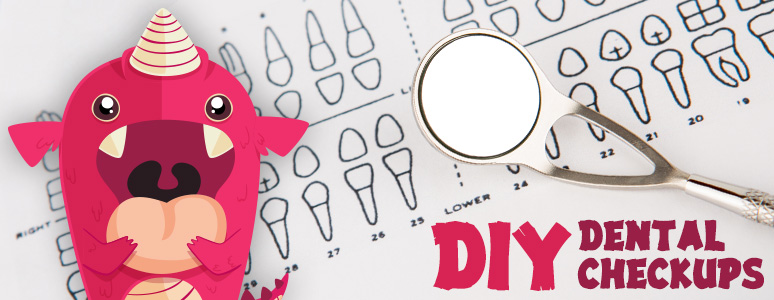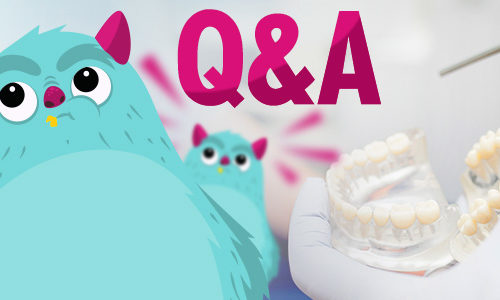
DIY Dental Checkups – Self-Checking and Diagnosing Teeth for Cavities
Caution! This article is for dental nerds or people who would love to see and know more than a regular patient. Please be aware that self-checking your teeth does not substitute checkups performed by a dentist and it should not prolong intervals between seeing your dentist. If anything, it should make you visit your dentist sooner if you notice any spots that bother you!
In this article you will learn the following skills:
- Professional naming of teeth and their surfaces
- What is the purpose of checking your teeth
- What tools do you need for self-checking your teeth
- How to perform proper self-checkup
- What to look for and if dark spots are always caries
- What to do if you spot anything alarming on your teeth
- Other forms of teeth assesment: cold test & percussion test
One of the most common dental issues that many people face are cavities. Although the diagnosis of cavities is best left to dental professionals, it is useful for individuals to be able to assess their oral health for early signs of cavities. This article provides an overview of self-assessment and the importance of professional diagnosis for cavities.
What Cavities Are?
Cavities, also known as caries or tooth decay, are permanently damaged areas in the hard surface of the teeth that develop into tiny openings or holes. They are caused by a combination of factors, including bacteria in the mouth, frequent snacking, sipping sugary drinks, and not cleaning teeth well.
How to Self-Assess for Cavities
1. Tooth surfaces
Each of your teeth has 5 surfaces that need to be inspected when doing a self-check. Let’s learn their naming system of them before we begin, as this will surely make it easier for you to communicate anything troublesome to your dentist. To identify a specific area of a tooth you name the tooth by its number (see next paragraph for reference), but also it is necessary to utilize a specific named surface, according to where it is located.
Please see the list of tooth surfaces for reference:
Distal – The surface that is away from the midline of the face.
Facial – The surface that faces the cheeks or lips. Can also use the terms:
Labial – The surface towards the lips.
Buccal – The surface towards the cheeks.
Incisal – The biting edge of an anterior tooth.
Lingual – The surface that faces the tongue.
Mesial – The surface that is closest to the midline of the face.
Occlusal – The chewing surface of posterior teeth.
Proximal – Tooth surfaces that are next to each other (i.e., distal of the lateral incisor and mesial of canine).
Teeth types and their numbers
To precisely communicate which teeth you mention it is important to learn the Universal System, in which permanent dentition is numbered from 1-32 beginning with the maxillary right third molar. There are also other designation and identification systems but in English-speaking countries this one is the most popular.
2. What is the purpose of doing self-checkups?
Why should I do that if I’m visiting my dentist every 6 months? – you may ask. While this is a good question, the answer may surprise you! Thing is, with regular weekly checkups we’re not looking for cavities or decay (caries) – instead, you’ll be mostly looking for white spots on your teeth. These are signs of demineralisation, which (if spotted early enough) is reversible. Being able to locate such spots right after they appear to give you perfect conditions to prevent them from becoming a cavity – yes, you heard us right: dental caries is fully preventable.
3. What will you need to self-check your teeth?
While you may be able to see some parts of your lower and upper teeth by just starting into a mirror please be aware that the accessories listed below are necessary to be able to see your teeth well – that is every surface of every tooth.
- small regular mirror ie. from a makeup kit (please clean thoroughly before use in your mouth)
- dental mirror (can be purchased online cheaply)
- highly absorbent towel (dentist will air-dry your teeth for assesment, a towel is your only option to do that)
- LED flashlight with adjustable output power, preferably also adjustable beam (zoom function)
- regular bathroom mirror on the wall (bathroom should not be too dark)
- …and last but not least: skill and knowledge
4. How to perform a proper self-checkup?
Obviously, you need to have your teeth cleaned first, so start with flossing (or use a Waterpik), then brush your teeth well, 3 minutes should be enough! Remember not to brush too hard and use proper brushing techniques, if uncertain please check our site for help. Now, remember how your dentist looks at your teeth? He dries them using a stream of air – that’s because saliva makes it difficult for proper assessment. Since you have no air source you can use a highly absorbent towel instead. Just remember to spit saliva first, then use a towel to dry the remaining moisture that’s left in your mouth. Now you have a couple of seconds to have a good look before you would have to repeat the drying procedure if you need some extra time.
Stand in front of your bathroom mirror and grab a LED flashlight and a dental mirror. To see everything clearly remember not to use the flashlight at full power, since it may be too bright in that setting. Remember that every tooth has 5 surfaces so that is what you want to check. If you already have some fillings be extra careful to look at their margins.
Take your time and learn to know your teeth. If you have an OPG X-ray radiograph have a look at it first. Analyze which teeth have fillings and how deep these fillings are. Now try to locate these fillings in your mouth. At first, you may not be able to recognize them, but the more time you spend doing this the easier it will be!
5. What to look for and if dark spots are always caries
You may think that tooth decay presents itself as brown or black spots on your teeth. While this of course is true, you may be surprised that it’s not these kinds of spots that we’ll be looking for. Given that you visit your dentist (at least) every 6 months and during your last appointment your dentist has fixed all the decay or simply said that your teeth are fine quite likely that there will be no decay presenting as dark spots. Instead, you will be looking for white spots, so-called white spot lesions, which are signs that your enamel is demineralized.
Another thing to look at is your fillings margins. These spots are where recurrent (secondary) decay likes to start. Dark margins may also mean that your filling is starting to fail and may need to be replaced soon. Look for grayish areas close to filling margins – these may suggest that the decay is growing under the enamel giving it the gray look. Healthy filling margin has the same tooth color like the rest of the tooth!
6. So I have spotted white lesions on my teeth, what should I do?
It is really powerful to know that you have white spot lesions on your teeth because they are fully reversible, so you can heal your teeth without having them drilled. Below we present steps to achieve this goal:
- Limit your carbohydrate intake
- Improve your oral hygiene
- Use fluoride gel or have a varnish applied by your dentist
- Use liquid enamel remineralizing gel with hydroxyapatite
- Have your teeth checked
- Find a dentist that performs ozone therapy ie. HealOzone
7. Other forms of teeth assessment
If you find anything suspicious or have problems with a particular tooth there are other tests that you can perform at home to gather additional information on the condition of your teeth.
1. Cold Test
This is the most important test to check if a tooth is vital. It is also a great test to find which tooth causes pain in a certain area or which tooth caused an abscess that is visible on the X-rays.
- Purpose: To evaluate the response of the pulp to cold stimulus
- Method: A material like ice or a refrigerant spray is applied to the tooth
- Response: A healthy tooth will respond with a brief, sharp sensation that dissipates quickly. A prolonged or lack of response may indicate pulp damage
2. Heat Test
- Purpose: To check the pulp’s reaction to heat
- Method: A heated instrument or warm water is applied to the tooth
- Response: Similar to the cold test, the sensation should be brief in a healthy tooth. Altered response may signify a problem
3. Percussion Test
- Purpose: To identify inflammation in the tissues surrounding the tooth’s root
- Method: The tooth is gently tapped with an instrument
- Response: Pain or tenderness may signal inflammation or infection related to pulp health
4. Palpation Test
- Purpose: To detect tenderness or swelling in the supporting tissues
- Method: The gums and surrounding tissue are palpated (pressed) with the fingers
- Response: Sensitivity may be indicative of an issue connected to the tooth’s vitality
Your dentist can also perform other test, including:
- X-ray imaging, CBCD scans
- DiagnoCam assement
- DiagnoDent assement
- Electric Pulp Testing (EPT)
- Laser Doppler Flowmetry
- Pulse Oximetry
Bottom Line
Being proactive and vigilant in monitoring your oral health can be advantageous in identifying the early signs of cavities. However, it’s crucial to remember that self-assessment is not a substitute for regular dental check-ups. Professional diagnosis is essential for maintaining optimal dental health and preventing the progression of cavities. Combining a regimen of home care with regular visits to the dentist is the best strategy for combatting cavities and ensuring a healthy smile.
This article is still a work in progress and was published on November 9, 2019, and last updated on August 22, 2023.




